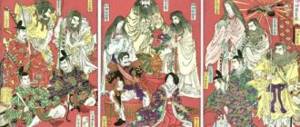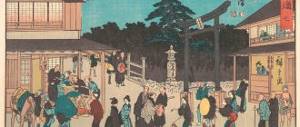Biography
Little Sadako was born in Japan and grew up as a very gloomy and unsociable child. Despite all the parents' attempts to help their daughter establish communication with peers, she still did not want to make friends.
Sadako's mother was a famous psychic. She helped people, but there were times when she was sometimes mistaken. In order to prove to others that she has occult abilities, she agreed to an experiment with Dr. Fukurai in Tokyo. Based on the results of the tests, the doctor came to a final conclusion, according to which the woman had psychic abilities, but their strength was insufficient for great things.
This conclusion only spurred the psychic’s enemies to action, and they began to spit in her direction. Sadako's mother could not bear such humiliation and committed suicide.
After this, the little girl withdrew even more into herself and moved to a remote island with her father. As the girl grew older, he began to notice her unusual abilities. Her father decided to show her to the same Dr. Fukurai.
The experiments on the subject brought the doctor into furious delight. The girl could mentally draw on film. No one in Japan has managed to do this.
The doctor wanted to show the discovery to the world and write a book about it. But the girl refused, remembering the bitter fate of her mother.
Further events are terrible: the doctor was afraid that someone else would discover Sadako’s abilities, and then the glory would go to someone else. He tricked the poor girl into a nearby thicket, strangled her, and threw her into a log, which he covered with a heavy stone.
But Sadako miraculously survived and tried to escape, but all attempts were in vain. The unfortunate girl spent another 7 days at the bottom of the well before she died. During this time, terrible evil and hatred for the whole world awakened in her.
Her anger was projected onto a videotape that promised death to anyone who watched it. The only way to escape death in a white robe with long black hair is to copy the tape and let someone else watch it.
Reflection of Japanese mythology
Since ancient times, Japan has believed that ghosts most often come in the dead of night. During drizzling rain, the chances of meeting them increase significantly.
Suzuki organically transferred these traditional Japanese ideas about the other world to paper. He considers the most suitable place for a ghost to appear in a damp, confined space. This is what the well eventually becomes.
The ghost girl Sadako Yamamura is a clear reference to yurei. This is what ghosts are called in Japanese mythology. They usually appear in the form of a young girl wearing long white clothes with flowing hair. Yurei were classically depicted as legless, but modern ghosts are often given legs. Apparently, this makes ghosts even scarier. The presence of legs brings them closer to reality and separates them from the numerous flying ghosts, which over decades of efforts by animators have become more funny than frightening.
The realism and tangibility of horror determined the incredible success of The Ring. This turned out to be easy to achieve - thanks to that very cassette, which is both an everyday object and a point of contact with the world of ghosts.
The well is another image characteristic of Japanese folklore. It was this structure, intended for the extraction of life-giving water, that, by evil irony, became the place of death for many characters in the legends of yurei.
However, not everything in “The Ring” corresponds to centuries-old Japanese traditions. The already mentioned viral spread of the curse is the director’s innovation. In Japanese mythology, a ghost finds peace after taking revenge. For this, one ruined traveler will be enough, who, to his misfortune, decided to spend the night in an empty old house in the forest. For Hideo Nakata, the goal of the curse is to spread it to its maximum extent.
Movies, novels, games and anime
The image of Sadako, the ghost from the well, has served as the basis for Japanese novels, films, games and anime.
- In the novel "The Ring" her whole sad story was told, but the character does not appear in real time. In "Spiral" she was assigned a role - she dreamed of filling the world with her doubles. The novel "Loop" briefly intersected its events with the chronicle of her life, and "Birth" describes the touching love story of Sadako and Toyama.
- The Japanese horror film "The Ring" is entirely based on the life story of Sadako. The main difference from the book is that the ghost kills people in real time. The sequels to the famous film “Call 0” and “Call: Virus” slightly alter its story, filling it with horrific details.
- After the release of the horror film, the girl from the well becomes the heroine of Japanese anime. But this genre contributed to her story and added sadness, warmth and endless melancholy to her. The white-robed ghost character is a favorite character that Japanese schoolgirls often transform into.
- The computer game of the same name is dedicated to Sadako . It greatly distorts its history, but despite this, millions of fans of this saga have not stopped playing it for several years.
The girl from the well is unlikely to stop scaring the Japanese. The longer her story lives, the worse her atrocities become.
From Sadako Yamamura to Samara Morgan: A Brief History of the Girl with Black Hair
It all started with the novel “The Ring” by Koji Suzuki, which was published in 1991. In 1998, director Hideo Nakata made the very first “The Ring” based on it, and the scene in which a wet Sadako crawls out of a well into a room from a TV screen, scaring the protagonist to death, became one of the most amazing scenes in cinema history.
Then it started. South Korean filmmakers were the first to remake the film, which instantly became a cult classic. In 1999, Dong-bin Kim directed the film "The Ring: Virus", where Sadako Yamamura turned into Park Eunsu, but remained a hermaphrodite, as in the novel.
The second remake was directed by Gore Verbinski in 2002. In the American series, Sadako became Samara Morgan, the adopted daughter of Richard and Anna Morgan. The girl had the ability of projection thermography - she could “burn” images and memories into the minds of any living beings or onto any recording media, as she did with that very cassette. Unlike Sadako, who was 19, Samara was 7 and lived only seven days in the well where her exhausted adoptive parents took her.
Since then, the Japanese and American series have evolved. The first, with all the sequels, prequels and side-quels, already contains seven films, two of which were released in 3D. And the second one is more modest, it has only three films.
From today all of them are on ivi, and the editors invite the most daring to the world of Samara.
- Call
Rachel is a journalist who investigates the terrible events that happen after watching a mysterious videotape. Everyone who watches it lives for another week, and then inevitable death... Unintentionally, the tape ends up in the hands of her son, who is now also in danger of death. She faces a race with death in an attempt to change at least something and find an explanation for everything that is happening.
- Ring 2
Direct continuation of the first film. To get rid of the nightmare memories and start a new life, Rachel and her son move to a small town in Oregon. But when a murder is committed and a mysterious, unsigned videotape is discovered at the crime scene, Rachel realizes that the vengeful Samara is back and intends to continue her reign of terror. In the fight for her life and her son's, Rachel must once again confront Samara.
- Calls
A special and modern continuation of the story, in which you will not see the actors of the previous films.
This picture turned out to be more technological, youthful and less predictable than classic films. Have you seen who Davey Chase, who played Samara in the first and second films, has grown into? April 25, 2021
Time for hope
Sadako Sasaki grew up active and cheerful. Mom, looking at her, began to believe that everything would be fine with the girl. She grew up and went to school. Each passing day gave more and more hope. People were dying all over the city, including relatives and neighbors. At first it was believed that they suffered from dysentery. But after some time it became clear that the fatal disease was brought by a bomb. It was radiation sickness.
Studies have established that approximately 90 thousand people died directly from the explosion in Hiroshima. It was not possible to establish the exact number. At the epicenter of the explosion, living beings evaporated, disintegrating into molecules and atoms in a matter of seconds, as the temperature was 4000 degrees Celsius. The light radiation left only dark silhouettes of people on the surviving walls. People turned into coal and dust, even birds burned in flight.
The consequences of the explosion were also terrible. A total of 286,818 people died from radiation sickness and cancer in Hiroshima. In Nagasaki, the explosion allegedly killed up to 80 thousand residents, and 161,083 from its consequences.
Sadako Sasaki and a thousand paper cranes
The girl did not want to die, she dreamed of living with her mother, whom she loved very much. One day, her school friend Chizuko Homomoto came to the hospital and brought scissors and origami paper. She told Sadako that there is a legend according to which cranes bring people happiness and long life. When a person is sick, he needs to make a thousand paper cranes, which will definitely bring recovery.
This simple tale inspired the girl, and now she made cranes every day. The paper soon ran out. Sadako began to fold them from everything that came to hand - paper napkins, magazine and newspaper sheets. But she had less and less strength left; on some days she could make one or two birds. The time allotted by fate was enough for the girl to make only 644 cranes. She died on October 25, 1955.
Memorial Day
Every year on August 6, a ceremony is held at the Hiroshima memorial complex to commemorate the victims of the nuclear bombing of the city. The Japanese call it "Bomb Day". Local residents, relatives of the victims, and tourists from other countries take part in it. It starts exactly at 08-00 o'clock. The minute of silence is counted from 08-15. It was at this time that the city was covered by a wave of a nuclear explosion, in which thousands of people died and did not understand what happened to them. According to the organizers and city leadership, the goal of this event, as well as the entire complex as a whole, is to prevent such a horror from happening again.
Memorial complex in Hiroshima
There is a park and a monument to Sasaki Sadako here. It was designed by Japanese architect Kenji Tange. The park is located on what was once Hiroshima's busiest commercial and business district. There were shops, restaurants, and cinemas here. After the explosion, all that was left was a clear field. It was decided to create a memorial complex using public funds in memory of the victims of the nuclear bombing. It contains several monuments, museums, and lecture halls. Up to a million tourists from all over the world come here every year.
Interesting fact
At the time of the atomic bombing, a large number of Koreans lived in Hiroshima. More than 20,000 of them died in the atomic nightmare. A monument was erected to them in the Memorial Complex. It is not possible to establish the exact number of dead after the tragedy, since no one counted them due to belonging to an ethnic minority. More than 400,000 more Koreans were taken out of the country to Korea after the bombing. How many people died there from radiation exposure and related diseases, and how many remained alive is unknown.
From the well to the screens
In any case, horror knows few examples of such popularity as "Rings". The complex story of the series, born from an old Japanese fairy tale, reflected in books and films, has not ended for 26 years. Sadako is quite a veteran of horror films, on par with Freddy Krueger or Jason Voorhees from Friday the 13th.
And it will continue to do so, apparently, coming to screens year after year in new forms, continuing to scare horror fans out of their wits. Because her curse must be passed on.
How to summon Hanako[edit]
1. If you knock three times on the door of the third stall of the women's restroom and say: “Hanako-san, let's play!”, you will hear: “Yeah…” and a ghost of a girl will appear. She has a red skirt and bob hairstyle.
2. One person enters the second toilet stall from the entrance, the other stands outside. The one outside knocks 4 times, the one inside knocks 2 times. Then you need more than two people to say in unison:
- Hanako-san, let's play! Do you want a rubber band or a tag?
A voice will be heard:
- Fine. Let's go tag.
And then the one inside will be touched on the shoulder by a girl in a white blouse...
3. Hanako-san can be called by knocking on the booth door (usually three times), calling her by name, and asking a specific question. The most common question is simply: “Are you there, Hanako-san?” If Hanako-san is really present, she says in a weak voice: “Yes, I’m here.” Some stories claim that a daredevil who decides to open the door is greeted by a little girl in a red skirt and then dragged off to the toilet.
Disease
Trouble came suddenly. At the age of 12, Sadako Sasaki's lymph nodes began to swell. The first harbingers of the disease, insidious tumors, appeared behind the ears and on the neck. Everyone who survived the nuclear bombing understood perfectly well what it meant. It was a sentence. Residents of Hiroshima were well aware of the symptoms of radiation sickness (leukemia) and were afraid of their occurrence.
This terrible disease was killing an increasing number of children and adults year after year. It has become known about it since 1950. Even children born after the terrible bombing, as their mothers survived it, were victims of the atomic bombing of Hiroshima.
The girl, once cheerful and active, began to get tired very quickly and could not stay awake for long. If before she played tirelessly with her friends, now she wanted to lie down more. She went to school and even did physical education. But one day I fell right in class and couldn’t get up. She was sent to the hospital. This happened in February 1955. Doctors told the crying mother that her daughter only had a year to live.











